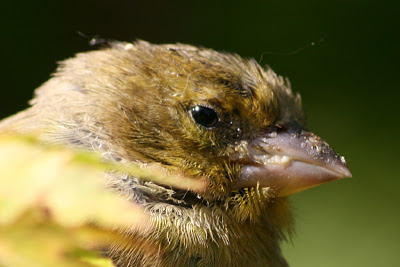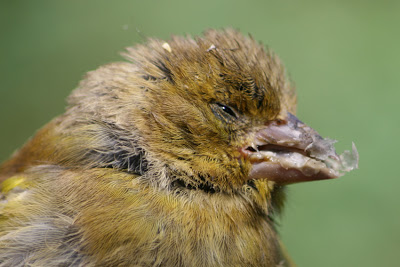Last week I posted photos of a greenfinch juvenile that I suspected of having the fat finch disease Trichomoniasis . I received a comment to this post confirming my suspicions. Yesterday I saw another Greenfinch and Chaffinch with it and when I walked up close to them they wouldn’t move – another sign of this condition. I went for my camera. I would guess that not everyone reads the comments on my posts but in this case as this one is quite graphic I have chosen to highlight it as it accompanies very well my more graphic close-up photos of this condition.
Jan from West Wales wrote: Hi Shirl, sadly I would say that the finch you have photographed definitely is sick with the tricho. It has virtually wiped out all the greenfinches and a huge number of chaffs here over the past months. If you find their bodies, as I have done many times, they are skeletal, the feathers are just fluffed up. The tricho blocks their throats and they can’t swallow, and they just starve to death. Its awful – takes them about 3 or 4 days to die. 🙁

 Today is the last day of August and I have a number of short posts I want to get in before we move into September –quite a wide range too. I wanted to get this one out of the way first. Much can change in the garden during the month of September – unless of course the weather surprises us with a late summer!
Today is the last day of August and I have a number of short posts I want to get in before we move into September –quite a wide range too. I wanted to get this one out of the way first. Much can change in the garden during the month of September – unless of course the weather surprises us with a late summer!
The photos above was taken in my garden on August 30th 2007.
Very sad, heartbreaking photos. Poor little things, but nothing apparently can be done for them. I tried putting stuff in the water which I bought from the birdcare company, its for canker prevention in pigeons, which is the same disease. The trouble is if it rains, it’s all diluted and a waste of time and money, and of course the sick ones may not even drink from it. The stuff doesn’t come cheap either, it’s about £15. Just hoping and praying eventually those that survive will build a resistance to it.
Hi again, Jan
No laughs for this post 🙁
Good hygenie at the feeders is about all we can do. I have let all my feeders slowly run out of food to encourage the birds to look elsewhere for a few days. Although many birds are still waiting around them.
Today I will take all the feeders down, clean and refill them once again. The problem of course is that they could pick this disease up at another garden and bring it back again. This cycyle will continue around our gardens and eventually this disease could wipe out these birds from our gardens completely.
Perhaps the RSPB Shops, Pet Shops, Garden Centres etc could put up notices about hygenie at garden feeders in the areas where they sell bird food and feeders. Although perhaps photos would work better.
I have used my camera to highlight this disease with images that wouldn’t be forgotten and together with your words I think we have told a very powerful story on behalf of these dying birds.
I thought I was the only one with greenfinches dying in my garden, I have had at least twelve to date and this morning there was a puffed up greenfinch on one of my feeder which looked exactly like the images taken and it died within minutes of me watching it but then I found a chaffinch dead under one of my bird feeders I am absolutely mortified is it me killing these lovely little birds? I am taking all my feeders down tomorrow. I live in Cobham in Surrey and am wondering if this disease is all over the UK or only the South.
Hello, Anon
Very sorry to read your comment – but thanks for sharing your experience 🙁
First off, please do not blame yourself for killing the birds in your garden. Yes, you have put up feeders and the birds have come to them but they will also find feeders in other gardens within a few miles of you. Your garden will just be part of a daily round that the birds take.
I really keep saying this but good hygiene at the feeders really helps stop this disease from spreading. I do believe this disease is widespread throughout the UK. The comment above came from Wales and I am in Scotland. I would like to suggest that you contact your local RSPB and speak to them and perhaps they will be able to tell you what the statistics are like in your area. They will perhaps also be able to reassure you about having feeders in your garden.
At this time of year the birds will begin to rely on the food we put out to give them energy to keep warm to survive cold nights. Ultimately it is your decision whether to take your feeders down but I suppose on the other side of that there are many other birds like the Blue Tits who will then have to find new food sources. I had never realised that birds do die overnight of cold and the food at our feeders helps to keep them alive.
I can completely understand how upsetting this must be for you knowing what is happening to these lovely birds – house sparrows and siskins can get this disease too. Sorry to add more to the list. Perhaps this is an especially bad time of year for it. Please do contact your local RSPB – I am certain they would be very understanding and supportive.
I am relieved know that it is not just my garden this is happening in. Over the last two months, I have had 9 greenfinches, one sparrow and one chaffinch die of this disease. I live in Norfolk. The poor little things look so pathethic and look as if they are asking for help, so it is sad nothing can be done for them. I noticed another in my garden today and I suspect that will be dead by morning, as it is quite cold tonight. I have regularly kept all my feeders clean and followed the advice of the RSPB and removed them for a short while when it was warmer. Six weeks I ago bought a Quill bird drinker/feeder with the nipples to drink from, so that the birds didn’t have to use the bird baths, but they took an age to feed from it and haven’t even touched the water. I do hope that they will eventually build up a resistance to this horrible disease, as they are such sociable little birds, always feeding in groups and singing so sweetly.
Chris
Hi Chris,
Very sorry to hear of another garden where the feeders are kept clean but the birds are still dying with Trichomoniasis. I agree with you the poor birds do look pathetic and in need of help when they have this disease.
I have had two Greenfinches with it recently myself – one I suspect a cat got as I saw some feathers remaining on the ground near the feeders. The other well, as you say, the cold night might have finished it off that is if the cat didn’t get that one too.
Usually the first time I notice the birds with this disease they are down trying to drink from my small pond. Yesterday I saw ‘the cat’ stalking it as it was on the rocks preparing to jump down to the water – I chased the cat away but no doubt it will be back again. I may move my CATWatch unit to this area for a little while.
You are clearly doing as much as you can do yourself to stop this disease spreading. I too hope the birds build up some resistance to it one day soon. I agree this group of birds would be a very sad loss in our gardens – they are already gone in others parts of the country. Thanks for sharing the story in your Norfolk garden.
Although the numbers of greenfinches have been in decline the last two years I fear next January the RSPB bird count will reflect a serious decline. With the RSPB ‘Feed the Birds Day’ on Saturday I do hope the message of good hygiene is strongly expressed at the ‘fun’ events that the RSPB have organised.